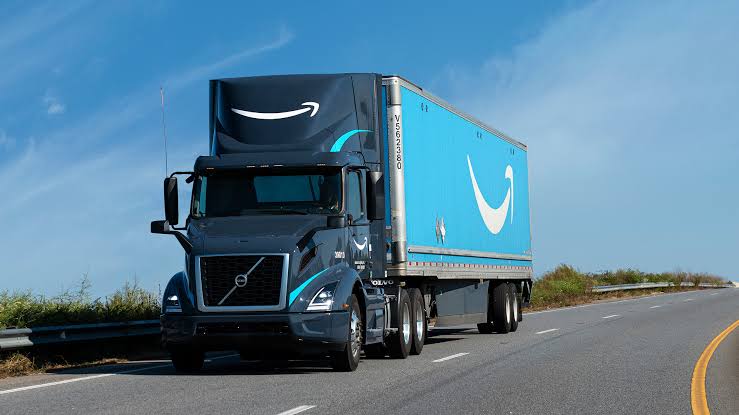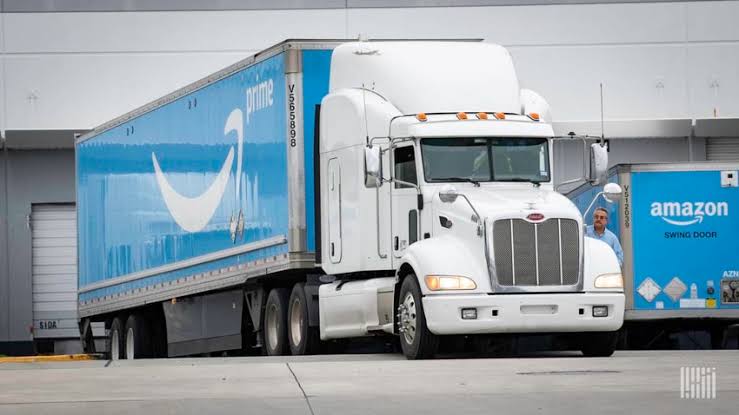Amazon Relay is a transportation platform designed to support freight partners in moving goods efficiently across the supply chain. It serves as an integral component of Amazon’s logistics operations, aiming to streamline the movement of freight for carriers and independent drivers who work with Amazon.
By providing a set of tools and features tailored to the needs of freight partners, Amazon Relay helps improve the efficiency, transparency, and profitability of their operations.
One of the primary goals of Amazon Relay is to simplify the process of transporting goods for both Amazon and its carriers. The platform provides freight partners with access to a wide range of loads, real-time updates on shipments, and a streamlined booking process.
This allows freight partners to maximize their time on the road and minimize downtime, ensuring more efficient routes and faster deliveries. Moreover, Amazon Relay integrates with other Amazon services to create a seamless logistics network, which is beneficial for both the retailer and its transportation partners.
A key benefit of using Amazon Relay is the access it provides to a vast array of available loads. By leveraging Amazon’s extensive network of fulfillment centers, distribution hubs, and delivery stations, freight partners gain access to numerous opportunities for transporting goods across various regions.
This increases the consistency of work and creates a steady stream of income for drivers and carriers. The platform also includes features that allow freight partners to view available loads in real-time, enabling them to choose the most convenient and profitable options.
In addition to offering a broad selection of loads, Amazon Relay provides its freight partners with tools that help manage their operations more effectively. For example, the platform offers real-time load tracking, allowing freight partners to stay informed about the status of their shipments at all times.
This visibility enhances communication between the freight partner, Amazon, and the customer, ensuring that everyone is aware of any delays or changes in the schedule. It also helps drivers plan their routes better by providing accurate, up-to-date information on traffic conditions, potential delays, and delivery requirements.
Another significant benefit of Amazon Relay is its integration with Amazon’s robust payment and invoicing system. Freight partners can rely on the platform to manage payments efficiently, ensuring timely compensation for their work.
This reduces the administrative burden on carriers and drivers, allowing them to focus more on driving and less on paperwork. Amazon Relay also provides freight partners with transparency regarding payment rates, ensuring that they are paid fairly for the services rendered.
The platform supports various payment structures, including per-mile rates, flat fees, and other customizable arrangements that suit the needs of both Amazon and its freight partners. Amazon Relay also plays a role in improving the safety and reliability of the freight industry.
The platform provides freight partners with access to a suite of safety tools and resources, helping them to adhere to industry standards and regulations. It includes features that allow freight partners to track their driving hours, monitor their compliance with safety regulations, and ensure that they are operating within the legal framework.
Amazon Relay also offers support for drivers in the event of emergencies or unforeseen situations, ensuring that they have the resources they need to address issues promptly and efficiently.
Furthermore, Amazon Relay supports freight partners with data-driven insights that can be used to optimize their operations. The platform offers analytics tools that provide information on performance, route efficiency, and delivery times.
By analyzing this data, freight partners can make informed decisions that enhance their overall productivity and profitability. These insights help carriers identify areas where they can improve their efficiency, reduce costs, and increase revenue.
One of the most appealing aspects of Amazon Relay for freight partners is the flexibility it offers. The platform allows drivers to select the loads they wish to transport based on their preferences, location, and availability.
This flexibility is a significant advantage for independent contractors who value the ability to manage their schedules. It also makes it easier for freight partners to scale their businesses by providing access to additional resources when needed.
Whether a carrier is looking for one-off shipments or regular, high-volume loads, Amazon Relay accommodates different business models. In addition to providing operational support, Amazon Relay offers its freight partners a range of benefits related to customer service and engagement.
Freight partners who use the platform have direct access to Amazon’s dedicated support team, ensuring that any issues they encounter can be addressed quickly.
This dedicated support helps reduce the stress and challenges that often come with managing logistics and ensures that freight partners can focus on delivering high-quality service to Amazon and its customers.
For carriers looking to expand their businesses, Amazon Relay provides opportunities to grow and scale operations. As the platform continues to grow and evolve, new features and opportunities become available, creating additional avenues for freight partners to increase their earnings.
Amazon’s commitment to innovation and improvement in logistics ensures that freight partners can continue to benefit from the platform as it evolves, with new opportunities for growth and expansion.
The relationship between Amazon and its freight partners is built on mutual benefit. Amazon Relay enables freight partners to operate more efficiently, reduce costs, and increase revenue by providing a steady stream of work, access to cutting-edge technology, and a robust support system.
This, in turn, helps Amazon meet its supply chain needs and deliver goods to customers more quickly and reliably. The success of Amazon Relay depends on the strong collaboration between Amazon and its freight partners, with each playing a vital role in ensuring the smooth operation of the platform and the logistics network as a whole.
Read Also: Amazon Flex: The Ultimate Guide to Earning Fast and Efficiently
How to Get Started and Maximize Efficiency on Amazon Relay

Amazon Relay offers a powerful platform for freight partners to connect with loads and improve the efficiency of their transportation operations. For those looking to get started with Amazon Relay and maximize its benefits, it is essential to understand the process, tools, and strategies to optimize operations.
1. Sign Up and Set Up Your Account
The first step in getting started with Amazon Relay is to sign up and create an account on the platform. To do this, you must meet certain eligibility criteria, such as having a valid operating authority (MC or DOT number) and proper insurance coverage.
After ensuring that your company meets the necessary requirements, visit the Amazon Relay website to complete the registration process. During this step, you will need to provide essential information about your business, including your transportation capabilities and contact details.
Once registered, you will be able to access the Amazon Relay dashboard, where you can view available loads, track shipments, and manage your operations.
2. Familiarize Yourself with the Amazon Relay Platform
After setting up your account, it is important to familiarize yourself with the platform’s features and tools. Amazon Relay offers a user-friendly interface that enables you to browse and book loads, track deliveries, and receive real-time updates. Spend some time exploring the dashboard and understanding the various sections, such as:
a. Load Board: This is where you can find available loads for delivery. It displays relevant details about the loads, such as the pickup location, destination, and pay rates.
b. Job History: This section provides an overview of the loads you have completed, including payments and performance metrics.
c. Notifications: Amazon Relay sends updates regarding shipments, cancellations, and changes to delivery schedules, so it is crucial to check this section regularly.
The more you understand the platform, the more effectively you will be able to manage your operations.
3. Choose the Right Loads for Your Business
One of the key features of Amazon Relay is its load board, which displays various delivery opportunities. When selecting loads, it is important to choose the ones that align with your operational capacity, schedule, and profitability goals. Take into account the following factors when choosing loads:
a. Location: Ensure that the pickup and delivery locations are convenient for your operations. This reduces time spent on long routes and ensures efficient utilization of resources.
b. Size and Weight of Loads: Match the loads to the size and capacity of your vehicles. Avoid taking on more than your equipment can handle.
c. Payment Structure: Evaluate the payment terms for each load, including whether it is paid per mile or as a flat fee, to determine the most profitable option for your business.
By selecting the right loads, you can optimize your route planning and reduce unnecessary operational costs.
4. Optimize Your Route and Time Management
Maximizing efficiency on Amazon Relay requires effective route and time management. Once you’ve chosen the loads, plan your routes to minimize delays and optimize travel time. Utilize Amazon Relay’s integrated tools, such as real-time traffic updates, to adjust your routes accordingly. A few best practices include:
a. Plan for Peak Traffic Times: Consider traffic patterns and avoid routes with high congestion, especially during peak hours.
b. Use GPS and Mapping Tools: Use integrated GPS and mapping tools to ensure the most efficient routes are taken.
c. Minimize Layovers: Ensure that layovers, whether at rest areas or warehouses, are minimized to reduce idle time and increase profitability.
Effective route management ensures faster deliveries, improved customer satisfaction, and reduced operational costs.
5. Utilize Real-Time Tracking and Communication Tools
Amazon Relay offers real-time tracking of shipments, allowing you to monitor the status of deliveries at all stages of the transportation process. Use this feature to stay updated on any changes or potential delays, so you can make adjustments in real-time.
Additionally, stay in constant communication with Amazon’s customer support team if you encounter any issues. Timely communication can help resolve problems quickly and prevent delays from affecting your business.
Moreover, ensuring that you maintain communication with your drivers or fleet, if applicable, helps in adjusting routes and managing on-the-road logistics more effectively.
6. Ensure Safety and Compliance
Safety and regulatory compliance are essential to running a successful transportation business. Amazon Relay has built-in features to help freight partners remain compliant with industry regulations, but it is ultimately the responsibility of the driver or carrier to ensure adherence to safety standards. To maximize efficiency, consider these practices:
a. Maintain Proper Documentation: Ensure that all your trucks and drivers have the necessary permits and insurance as required by law.
b. Megular Maintenance: Maintain vehicles in good working condition to avoid delays or unexpected breakdowns.
c. Driver Hours and Rest Periods: Make sure drivers comply with hours of service regulations to ensure safety on the road.
By adhering to safety standards, you reduce the risk of accidents, delays, and fines, all of which contribute to the overall efficiency of your business.
7. Monitor Performance and Analytics
Amazon Relay provides analytics tools that can help freight partners monitor performance, assess profitability, and identify areas for improvement. These tools allow you to review data on:
a. Delivery Times: Monitor whether deliveries are being completed within the expected time frames.
b. Earnings and Payments: Track the earnings from different loads and assess whether your payment rates align with your profitability goals.
c. Load Performance: Review the success rate of completed loads, including cancellations or delays.
Using this data, you can fine-tune your strategy, adjust load selection criteria, and improve overall operational efficiency.
8. Invest in Technology and Tools
To further maximize efficiency on Amazon Relay, consider investing in additional technology and tools that can support your operations.
For instance, fleet management software can provide more advanced tracking and analytics, while routing software can help optimize delivery routes in real time. Additionally, investing in automated billing and invoicing software can help reduce administrative overhead.
By leveraging technology to support daily operations, you can improve the overall management and productivity of your business.
9. Maintain a Flexible Schedule
Flexibility is a key component of maximizing efficiency on Amazon Relay. The ability to adjust your schedule and adapt to changes in load availability or delivery deadlines allows you to increase your earnings and minimize downtime. Stay open to short-notice opportunities and be prepared to adjust your availability based on peak demand periods.
Common Challenges and Tips for Success in Amazon Relay

As with any logistics and transportation platform, freight partners using Amazon Relay can encounter a variety of challenges. However, understanding these obstacles and implementing strategies to overcome them can significantly enhance success.
1. Managing Tight Delivery Deadlines: One of the most common challenges for carriers is adhering to strict delivery timelines. Delivery windows are often narrow, and the pressure to meet them can be intense, particularly when external factors such as traffic, weather, or unforeseen delays arise.
Failure to meet deadlines can result in penalties or a damaged reputation, which may negatively impact future opportunities. To overcome this challenge, it is essential to plan ahead and ensure sufficient time for all stages of the delivery.
Utilize GPS and real-time traffic updates to stay informed about potential delays on your routes. Additionally, considering optimal rest stops and avoiding peak traffic times can help ensure timely deliveries. Planning well in advance and anticipating any possible disruptions is key to avoiding late arrivals.
2. Managing High Operational Costs: Operational costs, including fuel, vehicle maintenance, and labor, can be significant challenges that affect the profitability of a transportation business. These expenses must be effectively managed to maintain a healthy bottom line.
Freight partners often struggle with balancing cost-efficiency while ensuring high levels of service quality. To address high operational costs, freight partners should optimize route planning to minimize unnecessary mileage, reduce fuel consumption, and decrease overall travel time.
Additionally, maintaining vehicles in peak condition can prevent costly breakdowns that could further increase expenses. Leveraging technology, such as fleet management software, can help identify inefficiencies and provide insights to optimize operations.
Cost-effective load management is another useful approach, ensuring that each load taken aligns with business goals and profitability expectations.
3. Managing Unpredictable Load Availability: Freight partners sometimes face the challenge of dealing with unpredictable load availability. While the platform provides access to a load board, the availability of loads may fluctuate, leaving carriers with idle time between deliveries.
Prolonged idle time can result in lost income and inefficiency. To mitigate this issue, freight partners should diversify their business operations and not rely solely on a single platform.
By expanding their customer base or exploring other transportation channels, they can reduce the negative impact of load availability fluctuations.
Additionally, maintaining flexibility in scheduling can enable carriers to take on last-minute loads or adapt to sudden shifts in demand, maximizing their overall earnings.
4. Difficulty in Navigating New Technology: For some freight partners, particularly those with limited technological experience, learning to navigate new platforms or tools can present a steep learning curve.
Whether it’s managing digital paperwork, using tracking systems, or understanding automated billing, the integration of advanced technology can be overwhelming, especially for smaller operations.
Training and education are essential for overcoming this challenge. Carriers should take time to familiarize themselves with the platform’s interface and features, either through online tutorials or customer support.
Many platforms provide training resources or support services that can assist with troubleshooting common issues. Additionally, partnering with experienced users or investing in professional development programs can accelerate the learning process.
5. Ensuring Safety and Compliance: Compliance with industry regulations and safety standards is a challenge that every freight partner must navigate. Regulations relating to driver hours, vehicle maintenance, and cargo handling are essential to ensuring the safety of all parties involved.
Failure to comply with these regulations could result in fines, penalties, or even the suspension of services, which can disrupt operations. To succeed in this area, freight partners should regularly review and update their knowledge of local and federal regulations.
Maintaining accurate documentation, ensuring that drivers adhere to hours of service laws, and implementing routine vehicle inspections will help prevent legal issues.
Additionally, investing in safety training for drivers is an important step to reduce the likelihood of accidents and ensure that operations remain smooth and compliant.
6. Handling Cancellations and Delays: Cancellations and delays are often unavoidable in the logistics industry, and they can significantly impact a freight partner’s reputation and profitability.
When a load is canceled at the last minute or delayed due to unforeseen circumstances, it can disrupt the entire schedule and lead to inefficiencies. To minimize the effects of cancellations and delays, it is crucial for freight partners to maintain clear communication with both drivers and clients.
Having a flexible schedule and backup plans can also be helpful in adjusting quickly to last-minute changes. In addition, building strong relationships with clients and service providers can provide more stability during challenging situations.
It is also advisable to seek compensation or renegotiate terms if delays or cancellations are caused by external factors beyond your control.
7. Maintaining High Customer Satisfaction: In the competitive world of logistics and freight services, maintaining high customer satisfaction is essential to securing repeat business and building a positive reputation.
Carriers may struggle with customer expectations, especially when faced with delays or damage to goods in transit. Negative customer experiences can result in lost contracts and reputational damage.
To enhance customer satisfaction, freight partners must prioritize clear communication throughout the delivery process. Providing customers with updates and responding promptly to inquiries shows professionalism and builds trust.
Additionally, ensuring that goods are handled properly and that deliveries are on time will contribute to positive feedback and long-term relationships. Incorporating a customer service mindset into all aspects of business operations can improve overall satisfaction and result in greater client retention.
8. Managing Cash Flow: Maintaining consistent cash flow can be a challenge for freight partners, particularly in a business where payments may be delayed or inconsistent. Cash flow issues can impact the ability to pay drivers, manage vehicle expenses, or expand operations.
To alleviate cash flow concerns, it is important to maintain a detailed financial plan and budgeting strategy. Setting aside a reserve fund can help handle periods with less income or longer payment cycles.
Establishing clear payment terms with clients and ensuring that invoices are processed promptly can also help stabilize cash flow.
Additionally, diversifying revenue streams, such as offering additional services or working with multiple platforms, can reduce the pressure on cash flow from any single source.
9. Maximizing Profitability from Loads: Maximizing profitability is one of the ultimate goals of any freight partner. Carriers often face the challenge of finding the right balance between taking on enough loads to generate sufficient income while avoiding overloads that can lead to delays or damage to goods.
To succeed in maximizing profitability, freight partners should regularly evaluate the pay structure of available loads and prioritize those that offer the best returns for the resources involved.
Strategic planning, such as grouping nearby deliveries together or optimizing multi-stop routes, can help increase the volume of deliveries without significantly adding to costs. Over time, consistently focusing on high-margin loads and refining route strategies will enhance the overall profitability of the business.
Read Also: A Guide to Managing Your Amazon Login Account Safely and Easily
Frequently Asked Questions on How Amazon Relay Works: A Guide for Freight Partners

1. What is Amazon Relay?
Amazon Relay is a platform designed to connect freight carriers with available loads for transporting goods. The platform offers carriers the opportunity to bid on, schedule, and track freight shipments for Amazon, improving the efficiency of the delivery process. By utilizing Amazon Relay, freight partners can access an extensive network of routes, reducing downtime and optimizing their operations.
2. How do freight partners get started with Amazon Relay?
To get started, freight partners need to sign up on the Amazon Relay platform. The process involves creating an account, submitting required documentation such as business credentials, and meeting the platform’s requirements.
Once registered, freight carriers can access the load board, where they can bid on and select available shipments. Partners must ensure that their vehicles meet Amazon’s standards and that they comply with the platform’s operational guidelines.
3. What are the requirements to become an Amazon Relay partner?
Freight partners must meet certain criteria to become eligible for Amazon Relay. These requirements include having a valid motor carrier authority, insurance coverage, and a registered business. Additionally, carriers need to operate qualified vehicles that meet Amazon’s standards for size and type. S
uccessful registration also requires the completion of a background check and an understanding of Amazon’s safety and operational guidelines. Partners are also expected to maintain up-to-date certifications to remain in good standing on the platform.
4. How do carriers find available loads on Amazon Relay?
Once a freight partner has completed the registration process and logged into the platform, they can access the load board. The load board displays a range of available shipments, which can be filtered by location, vehicle type, and other preferences.
Carriers can browse through these listings and select the loads that best fit their schedules and capabilities. The platform also provides information about delivery windows, pickup locations, and load details, which helps freight partners make informed decisions.
5. What types of vehicles are allowed to operate on Amazon Relay?
Amazon Relay accepts various types of vehicles depending on the load requirements. Typically, the platform requires that freight partners operate vehicles that are in good working condition and meet the minimum size and weight specifications outlined by Amazon.
Common vehicle types used in Amazon Relay include box trucks, tractor-trailers, and flatbeds, among others. Each load will specify the type of vehicle required, and freight partners must ensure their fleet complies with these specifications before bidding.
6. How does Amazon Relay help carriers optimize their operations?
Amazon Relay offers several tools and resources to help freight partners optimize their operations. The platform’s load board is regularly updated with available shipments, allowing carriers to choose routes and deliveries that align with their schedules.
Additionally, Amazon Relay provides real-time tracking of shipments, helping carriers monitor the status of their loads and anticipate any delays. The platform also integrates with fleet management tools, offering insights into route efficiency, fuel usage, and vehicle performance. These features enable freight partners to reduce downtime and improve overall operational efficiency.
7. What happens if a freight partner misses a delivery deadline on Amazon Relay?
Meeting delivery deadlines is critical for success on Amazon Relay. If a freight partner misses a scheduled delivery window, it can result in penalties or removal from the load board. Amazon Relay has strict performance standards, and late deliveries can damage a carrier’s reputation on the platform.
Freight partners should communicate proactively with Amazon if they anticipate delays and, whenever possible, plan their routes to avoid tight delivery windows. Continuous performance monitoring is essential to ensure timely deliveries and maintain a positive standing on the platform.
8. Are there any fees associated with using Amazon Relay?
While there are no upfront fees to join Amazon Relay, carriers may incur costs associated with the use of the platform, such as fuel, maintenance, and vehicle insurance. In addition, Amazon Relay operates on a payment structure that involves service fees for certain transactions.
These fees may vary depending on the type of load, the distance traveled, and the specific requirements of the shipment. Freight partners should review the payment terms outlined on the platform to fully understand the cost structure.
9. How does payment work on Amazon Relay?
Payment on Amazon Relay is typically made on a per-load basis, with freight partners being compensated once the delivery is completed. The platform offers transparent payment terms, detailing how much a carrier will earn for each load.
Payments are processed within a set period after the successful completion of the delivery, and carriers can access their payment history through their Amazon Relay account. Additionally, partners can opt to receive payment via direct deposit, ensuring a streamlined payment process.
10. How can freight partners track their performance on Amazon Relay?
Amazon Relay offers performance tracking tools to help freight partners monitor key metrics such as on-time delivery rates, vehicle efficiency, and customer satisfaction. Freight partners can access a dashboard within the platform that provides an overview of their performance over time.
This data helps carriers identify areas for improvement and make adjustments to their operations to enhance their performance. High-performing partners may also receive priority access to certain loads, providing them with more opportunities and greater earning potential.
11. What support does Amazon Relay offer to freight partners?
Amazon Relay provides a range of support options to ensure that freight partners have the resources they need to succeed. This includes online help resources, customer service teams, and training materials.
Partners can access support for technical issues, operational queries, and troubleshooting advice through Amazon Relay’s dedicated help center. Furthermore, freight partners can participate in webinars and training sessions to enhance their knowledge of the platform and improve their operational capabilities.
12. What are the advantages of using Amazon Relay for freight partners?
Using Amazon Relay offers numerous advantages for freight partners. The platform provides access to a vast network of available loads, offering carriers the opportunity to increase their earnings and minimize idle time.
The system’s integration with real-time tracking and fleet management tools enables carriers to optimize routes and reduce operational inefficiencies.
Furthermore, Amazon Relay’s transparent payment structure and regular updates on available shipments ensure that freight partners can plan their operations effectively. The platform’s support for performance tracking and professional development further contributes to long-term success.
Read Also: Top 5 Most Trending Fashion Styles That Will Blow Your Mind
Do you have any questions, suggestions, or contributions? If so, please feel free to use the comment box below to share your thoughts. We also encourage you to kindly share this information with others who might benefit from it. Since we can’t reach everyone at once, we truly appreciate your help in spreading the word. Thank you so much for your support and for sharing!






